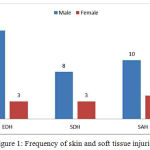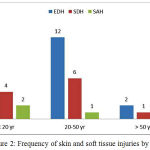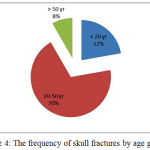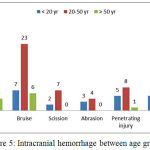Manuscript accepted on :February 24, 2017
Published online on: --
Plagiarism Check: Yes
Babak Mostafazadeh1, Siamak Sabouri2 and Esmaeil Farzaneh3
1Department of Forensic Medicine and Toxicology, Shahid Beheshti University of Medical Sciences, Tehran, Iran.
2Specialist in Forensic Medicine and Toxicology, Shahid Beheshti University of Medical Sciences, Tehran, Iran.
3Department of Forensic Medicine and Toxicology, Ardabil University of Medical Sciences, Ardabil, Iran.
Corresponding Author E-mail: dr.farzaneh.milad@gmail.com
DOI : https://dx.doi.org/10.13005/bpj/1213
Abstract
The aim of this study was to identify the epidemiological aspects of damages or injuries caused by disputes in a trauma center. This cross-sectional study included all victims of dispute that referred to trauma center in a hospital from April 2013 to April 2014. Necessary information were collected from the hospital recorded files and after entered in a checklist, analyzed by statistical methods in SPSS.19. In total, 132 patients were eligible for final assessment with the mean age of 30.86 ± 13.80 years (ranged 12 to 85 years) that 99 were male. The most used object was hard object (35.6%). Scratches and bruises had the highest frequency (16.7%). In total, 27.3% had skull fracture and 32.6% hemorrhage. Bone fractures and dislocations were found in 12.9% and 14.4%, respectively. The frequency of injuries in abdominal organs was 12.1%, mostly in liver (18.8%). Results showed that the conflicts and related injuries show that the conflicts occur predominantly in younger men and particularly using hard objects. A notable number of victims suffer skull fracture, chest wall injuries and intra-abdominal damages, but pelvic injuries are partially rare. Overall, the injuries caused by disputes similarly occur in both genders and different age groups.
Keywords
Dispute; Epidemiology; Injury; Victim
Download this article as:| Copy the following to cite this article: Mostafazadeh B, Sabouri S. Farzaneh E. An Epidemiologic Study of Injuries Caused by the Disputes Among Referral Cases to A Trauma Center, 2013-14. Biomed Pharmacol J 2017;10(3). |
| Copy the following to cite this URL: Mostafazadeh B, Sabouri S. Farzaneh E. An Epidemiologic Study of Injuries Caused by the Disputes Among Referral Cases to A Trauma Center, 2013-14. Biomed Pharmacol J 2017;10(3). Available from: http://biomedpharmajournal.org/?p=16744 |
Introduction
Currently, trauma is one of the main medical community problems that may results in irreversible damage and waste as well as imposing heavy cost burden on governments. Various types of trauma are regarded as the problems of the medical community and also as the leading cause of death in the first half of life and overall fourth leading cause of death (Saraswat et al.,2003). Assault and battery in terms of forensic medicine include the damage from the collision of the direct or indirect mechanical, physical, chemical and emotional injuries on human body caused by vehicle crashes, firearms and cold, dispute, Work-related injuries, electric shock, and earthquake (Clasper et al.,2003). In this regard, damages caused by dispute are of particular importance and thus identifying its underlying reasons has a tremendous effect on the prevention of these damages (Tay et al.,2015). The increase in dispute rate in our country in recent years shows that the Iranian community faces now with a serious increasing trend of the violence phenomenon especially among the younger (Hemmati et al., 2013). According to experts, rising inflation and the inability of the families in safeguarding the livelihoods, increasing the number of patients with addiction in the country, using substances particularly among young people, reducing the age of addiction, and loosening the foundations of social relationships are the main reasons that have contributed the incidence and escalation of violence in our country (Ghazizadeh et al.,2005; Sadeghi et al.,2014).
According to the industrialization of societies and increase psychiatric problems, the physical conflict and dispute have increased and thus the use of the different instruments for dispute has been diversified (Sadeghi et al. 2014). By identifying the factors exacerbating the conflict in the country, it can be feasible to reduce and prevent its related physical, social, and even economic damages. In total, because providing comments on type and severity of injury needs to recognize the right expertise based on scientific principles, the research to develop new diagnostic procedures and a review of past practices in this field seems to be essential. The aim of this study was to identify the epidemiological aspects of the types of damages caused by disputes and quarrels in a trauma center.
Material and Methods
Design
This cross-sectional study included all victims of dispute that referred to trauma center in a hospital from April 2013 to April 2014. The exclusion criteria were 1) the doubt to self-mutilation (intentional use of physical strength against the person), 2) age lower than 15 years, 3) deaths at the time of referral to hospital, 4) the lack of cooperation and 5) outpatient management.
Data collection and analysis
All study information including demographics, soft tissue, skin, and musculoskeletal damages, level of consciousness assessed by Glasgow coma scale (GCS), skull fracture, intracranial hemorrhage, chest, abdomen or pelvic damages, the time of dispute, type of tools creating injury, the length of hospital stay, needing admission to intensive care units, therapeutic approaches, and clinical in-hospital outcome such as death or disabilities were collected from the hospital recorded files and recorded at the study especial checklists.
Results were presented as mean ± standard deviation (SD) for quantitative variables and were summarized by absolute frequencies and percentages for categorical variables. Categorical variables were compared using chi-square test or Fisher’s exact test. Association between quantitative indices was determined using the Pearson’s correlation. For the statistical analysis, the statistical software SPSS version 16.0 for windows (SPSS Inc., Chicago, IL) was used. P values of 0.05 or less were considered statistically significant.
Results
In total, 132 patients were eligible for final assessment with the mean age of 30.9 ± 13.8 years (ranged 12 to 85 years) that 99 were male with the mean age of 30.4 ± 12.7 years and 33 were female with the mean age of 32.2 ± 16 years. The patients were more in the age range of 20 to 29 years (total 31.8%, 31.3% in male group and 33.3% in female group). Regarding objects for creating damage, the most used objects was hard objects with 35.6% and in summer with 40.9%. The victims were frequently transferred to the healthcare centers by EMS service with 84.1% and in admission, 59.1% had mild unconsciousness (GCS 15 to 13). There were statistical significant differences in the rate of disputes between sex, season, transition method and GCS.
Table 1: Demographic data collected from study
| variables | N(%) | p-value |
| Sex Male
Female |
99(75)
33(25) |
0.001 |
| Season Spring
Summer Winter Autumn |
34(25.8)
54(40.9) 20(15.2) 24(18.2) |
0.001 |
| Transition method Own
EMS Ambulance |
5(3.8)
111(84.1) 16(12.1) |
0.001 |
| GCS Normal
Mild (13-15) Moderate (9-12) Sever (3-8) |
43(32.2)
35(26.5) 39(29.5) 15(11.4) |
0.012 |
| Injury creation tools Hard object
Sharp object Unknown |
52(39.4)
37(28.1) 43(32.6) |
0.4 |
Regarding prevalence of soft tissue injuries, scratches and bruises had the highest frequency (57%) and abrasion and Scission had the lowest frequency (12%). (Fig.1) In this regard, other common types of soft tissue damages included bruise in 27%. As shown in Fig.2, there was no difference in the frequency and type of soft tissue damages between the different age groups. Briefly, the soft tissue damage was frequently as abrasions in young victims and as bruises in the elderly. We also found no difference in the type of soft tissue injuries between men and women, however scratches, abrasions, and lacerations were predominant in men and bruises were predominant in women (Fig.3). In total, 27.3% had skull fracture with the mean age of 30.8±12.6 years. Most of skull fracture with 27.6% was seen in the age group <20 years and there was significant difference in the frequency of skull fracture between age groups. (Fig.4)
 |
Figure 1: Frequency of skin and soft tissue injuries
|
 |
Figure 2: Frequency of skin and soft tissue injuries by sex
|
 |
Figure 3: Frequency of skin and soft tissue injuries by age groups
|
 |
Figure 4: The frequency of skull fractures by age groups
|
No difference was found in the rate of skull fracture between two sexes and various mechanisms of injuries. Regarding intracranial hemorrhage, 32.6% suffered hemorrhage which from them 41.8% have epidural hematoma (EDH), 25.6% subdural hematoma (SDH) and 32.6% subarachnoid hemorrhage (SAH). There was no difference in the type of intracranial hemorrhage between age groups and two genders. (Fig.5 and Fig.6) Bone fractures and dislocations were found in 12.9% and 14.4%, respectively. In this regard, bone fractures was closed in 10.6% and opened in 2.3%. Also, the fractures were linear in 73.3% and multi segment in 26.7%. Also, the fractures were accompanied with dislocation in 40.0%. Regarding chest wall injuries, rib fracture occurred in 1.5%, lung injuries in 4.5% and vascular injuries in 1.5%. All rib fractures occurred in the age range of 10 to 19 years, lung injuries occurred in the ages lower than 30 years and vascular damages in the age range of higher than 30 years (P = 0.001). No difference was revealed between men and women in terms of chest wall damages. Half of the lung injuries were caused by cutting and sharp objects, while chest wall fractures were caused by hard objects, however no difference was found between the type of chest wall injury and type of damaging tool. Regarding injuries in intra-abdominal organs, the frequency of injuries in these organs was 12.1%, mostly in liver followed by in intestines each with 18.8%. These damages led to internal bleeding in 18.8%. Intra-abdominal organ injuries occurred more in the age lower than 30 years that liver damages occurred more in the age range of 10 to 19 years (40.0%) and intestine injuries with bleeding occurred more in the age range of 20 to 29 years (40.0%). There was no difference in intra-abdominal organ injuries between men and women. Also, no relationship was found between the type of intra-abdominal organ injuries and type of damaging object. With respect to pelvic organ injuries, these injuries were found in 3.8% as bladder injuries in 0.8% and urinary tract in 3.0%. The prevalence rate of pelvic organ injuries did not differ between the different age groups. All pelvic organ injuries occurred in men and all of them caused by hard objects.
 |
Figure 5: Intracranial hemorrhage between age groups
|
 |
Figure 6: Intracranial hemorrhag between two genders
|
Discussion and Conclusion
In the present study, the age peak of damages caused by dispute was around 30 years old. Also, damages occurred more in the age groups 20 to 29 years that was similar to the report by Kiani and et al (Kiani et al., 2008), however, in some studies in western countries, the age of dispute was even lower (Drummond et al., 2015). In total, dispute is mostly reported among the younger due to their high feeling, excessive energy, and the arrogance in this age group. We showed that the dispute and its-related injuries were occurred notably more in men than in women (75.0% versus 25.0%). In Kiani and et al study (Kiani et al., 2008), more than 95% of victims were male. The investigations performed by Forensic Medicine Organization in different provinces showed that about 70% of all disputes occur among men (Saberi et al., 2013) that were also similar to the reports by the eastern and western areas (Joshi et al.,2009; Hishinuma et al., 2015). This discrepancy can be due to the presence of men outside the home and limitations for women. According to our survey, the injuries were frequently caused by hard objects, followed by cutting and sharp objects that was comparable with the report of Forensic Medicine Organization from different areas of the country. Similarly, in Afzali and et al survey (Afzali et al., 2006), the main tools in disputes are hard objects with the prevalence rate of 91.2%. In the study performed in North Karolina in 2009 (Montgomery et al., 2015), 68% of violence performed with the objects that among them, sharp and cutting objects were applied more than that reported from our area. It seems that high using hard objects in our study can be related to the absence of premeditation to conflict and also to conflicts caused by emotional factors. In our study, disputes occurred more in the summer that was comparable with the report by Forensic Medicine Organization (Saberi et al., 2013). In Afzali and et al study (Afzali et al., 2006), 32.3% of disputes occurred in the summer. Higher occurring conflicts in this season can be due to traveling most people in the summer during the day, unemployment among young people, and the lack of facilities for filling their leisure time. According to our survey, the victims had mostly mild unconsciousness and thus most of them had normal conscious level. In most cases of conflicts, because the hitter has a defensive condition, this leads to greater protection of the head and thus head trauma occurs less leading reduce the rate of losing consciousness. Also, we could show that most soft tissue injuries formed as scratches and bruises. In Kiani and et al study (Kiani et al., 2008), the injuries in the soft tissues occurred frequently as scratches and thus the injuries as fractures rarely occurred. In Afzali and et al study (Afzali et al., 2006), half of the injuries appeared as bruises. In our study, scratches and bruises more occurred among women and the elderly, while lacerations and fractures more occurred in men and especially in the younger. The higher rate of bruising in comparison with deeper and expander lesions in women may be due to especial coverage of women, their structural physiology and also getting the defensive in conflict with men.
In our study, skull fracture occurred in 27.3% of victims, especially in the younger. The rate of skull fracture in a similar study done by Rumsey and et al was about 10% which was considerably lower than our report. In our study, also, 32.6% suffered hemorrhage as epidural hematoma in 12.9%, subdural hematoma in 6.1%, and subarachnoid hemorrhage in 3.0%. In this regard, the most prevalent complication following head trauma was epidural hematoma and thus in all victims suspected to head trauma; fully assessment to follow intra-cranial hemorrhage is necessary. The rate of injuries following trauma to chest wall was nearly low, because of the serious consequences of chest wall damages, it should be seriously considered in all victims.
In our study, intra-abdominal injuries mostly were reported in liver and intestine in 12.1% of patients. These injuries can be caused by both hard and penetrating objects that injure vital organs including liver, gastrointestinal tract, spleen, diaphragm, and kidneys leading even massive bleeding. It has been shown that the least force for occurring liver injury is about 40j (Campbell et al., 1992). In total, because of high probability of internal massive bleeding particularly following penetrative injuries, comprehensive assessment of damage to the vital organs and occurrence of bleeding is essential. Furthermore, rarely report of pelvic injuries must not be led to ignoring damages in pelvic organs.
Conflict of Interest
None-declared
Authors’ Contributions
BM have made substantial contributions to conception and design, collected data and acquisition of data, or analysis and interpretation of data; SS have been involved in drafting the manuscript or revising it critically for important intellectual content; and EF participated in the design of the study and performed the statistical analysis. All authors read and approved the final manuscript.
Acknowledgment
The results of this study financially supported by Tehran University of Medical Science. We thank all the personnel of Shohada hospital (trauma section) for help in collected data and their necessary helps.
References
- Afzali S., Ghalei H. A. An epidemiological study of trauma and its injuries on persons referred to Hamedan Legal Medicine Center since 1381. J Legal Med Islam Repub Iran. 2006;12(2):73–78.
- Campbell D. B. Trauma to the chest wall, lung and major airways. Semin Thorac Cardiovasc Surg. 1992;4(3):234-40.
- Clasper J., Rew D. Trauma life support in conflict. BMJ. 2003;327(7425):1178-9.
CrossRef - Drummond H., Dizgun J. Keeling D. Role Differentiation in an Adolescent Victim-Offender Typology: Results From Medellin, Colombia. J Interpers Violence. 2015;20. pii: 0886260515584340.
- Ghazizadeh A. Domestic violence a cross-sectional study in an Iranian city. East Mediterr Health J. 2005;11(5-6):880-7.[ PMID: 16761657]
- Hemmati H., Kazemnezhad-Leili E., Mohtasham-Amiri Z., Darzi A. A., Davoudi-Kiakalayeh A.,Dehnadi-Moghaddam A.,et al. Kouchakinejad-Eramsadati L. Evaluation of chest and abdominal injuries in trauma patients hospitalized in the surgery ward of poursina teaching hospital, guilan, iran. Arch Trauma Res. 2013;1(4):161-5.
CrossRef - Hishinuma E. S. Chang J. Y. Goebert D. A.,Helm S.,Else I. R., et al. Interpersonal youth violence perpetration and victimization in a diverse Asian American and Pacific Islander adolescent sample. Violence Vict. 2015;30(2):225-49.
CrossRef - Joshi S. K., Shrestha S. Economic and social burden due to injuries and violence in Nepal a cross-sectional study. Kathmandu Univ Med J (KUMJ). 2009;7(28):344-50.
CrossRef - Kiani M., Bazmi S., Gharedaghi J., Barzegar A. A survey on frequency of trauma due to quarrel, in cases referred to the physical examination department for men – located in central branch of Legal Medicine Organization of IRI Iran- during 3 months. J Legal Med Islamic Repub Iran. 2008;48:256–60.
- Montgomery B. E., Rompalo A., Hughes J., Wang J., Haley D., Soto-Torres L. et al. Violence Against Women in Selected Areas of the United States. Am J Public Health. 2015;19:e1-e11.
CrossRef - Saberi S. M., Mirsepassi G. R. Forensic psychiatry in iran. Iran J Psychiatry Behav Sci. 2013;7(1):1-3.
- Sadeghi S., Farajzadegan Z., Kelishadi R., Heidari K. Aggression and Violence among Iranian Adolescents and Youth: A 10-year Systematic Review. Int J Prev Med. 2014;5(2):S83-96.
CrossRef - Saraswat V. Injury patterns in low intensity conflict. Indian J Anaesth. 2009;53(6):672-7.
- Tay A. K., Rees S.,Chen J., Kareth M.,Lahe S., Kitau R., et al. Associations of Conflict-Related Trauma and Ongoing Stressors with the Mental Health and Functioning of West Papuan Refugees in Port Moresby, Papua New Guinea (PNG). PLoS One. 2015;10(4):e0125178.
CrossRef







